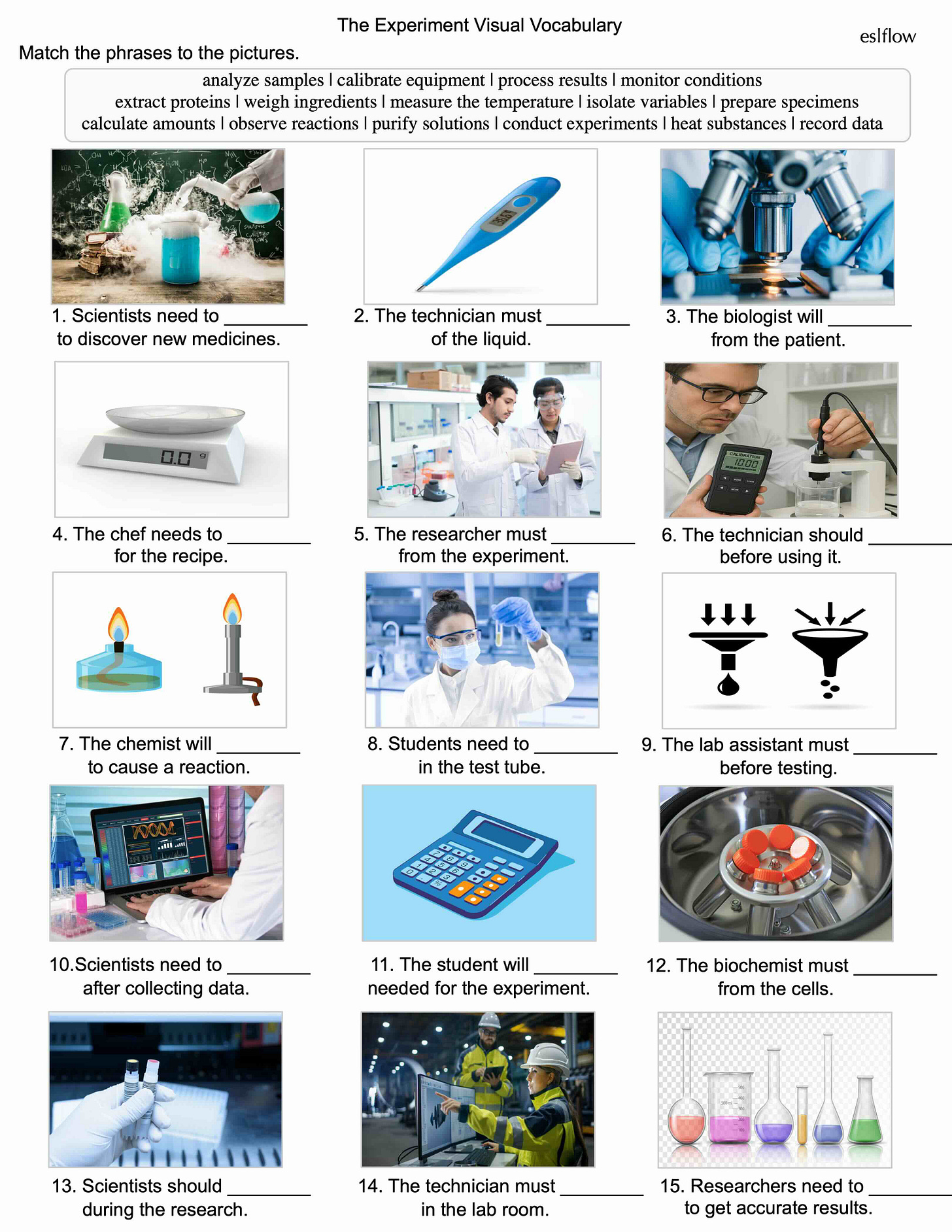Exploring The Language of Fears and Phobias
+ The Experiment: Communication Skills in the Laboratory
Today's post content:
11 exercises for fears and phobias
9 exercises for lab experiments
2 listening exercises for fears and phobias
2 listening exercises for experiments
2 pronunciation exercises for fears and phobias
2 pronunciation exercises for lab experiments
1 video for types of fears and phobias
Paid subscribers have access to download the complete materials at the end of the post.
Fears and Phobias Visual Vocabulary
Everyone experiences fear, but describing these feelings in another language requires specific vocabulary. This material teaches students important words about fears and phobias through images that show real situations—like feeling trapped in small spaces or being afraid of heights. They'll learn practical terms such as "anxiety," "panic," "sweating," and "heartbeat" that help explain both the feelings and physical signs of fear. Understanding this vocabulary is especially useful now when people talk more openly about emotional health and well-being in everyday conversations, at work, and in healthcare settings.
This material builds upon my previous resources on fears and phobias, offering significant improvements and more comprehensive practice opportunities. I've added new listening exercises, expanded vocabulary, collocations, and critical thinking activities to create a more complete learning experience. Despite the potentially sensitive nature of the topic, fears and phobias prove surprisingly engaging in classroom settings. Students typically enjoy discussing these subjects — similar to the thrill of watching a horror movie — from a safe distance that allows them to explore emotional vocabulary without confronting personal anxieties directly. The psychological distance creates a fun and engaging learning environment where students can practice these important communication skills.
Fears and Phobias: Critical Thinking
Today’s set of exercises includes 4 critical thinking exercises: general, environmental, social and work. These critical thinking activities help students think deeply about fears that matter in modern life while practicing important English skills. They will consider which fears are most widespread today, understand how our bodies physically respond when afraid, and evaluate practical methods for managing fears. The discussion connects directly to mental health awareness, which has become much more important in recent years.
What are you are afraid of? (listening)
Everyone knows what it feels like to be afraid of something. But when does normal fear become a phobia that limits your life? This listening practice follows Miguel as he talks with his doctor about how his fear of heights prevents him from visiting family, attending important events, and even taking better job opportunities.
Fears and Phobias Collocations
This collocations exercise helps students understand the specific word partnerships that English speakers naturally use when discussing phobias and anxieties. From "experiencing panic attacks" to "getting over fears," these language patterns appear constantly in podcasts, YouTube videos and discussions that students encounter daily. The activity builds fluency —preparing students to engage meaningfully in important conversations, whether they're discussing performance anxiety before a job interview or social anxiety in an increasingly digital world.
Fears and Phobias Wrap
This activity helps students learn exactly how to talk about different levels of fear in natural, everyday English. Beyond just learning vocabulary, students can listen to and practice real conversations about emotions—something many find challenging even in their native language. Understanding how to discuss fears precisely helps in doctor's appointments, travel situations, and workplace communications where expressing emotional states clearly matters.
The Experiment Visual Vocabulary (medical sciences focus)
Imagine yourself in a pharmaceutical research lab, where the difference between "extracting proteins" and "isolating variables" could impact the development of a life-saving medication. This visual laboratory tour connects technical terms to their real-world applications in medical and pharmaceutical settings, helping learners internalize vocabulary that appears in everything from textbooks to clinical trial reports.
By visualizing laboratory actions as they occur in research environments, pharmacy and medical science students build not just English vocabulary, but professional fluency that will serve them throughout their careers—whether analyzing diagnostic samples, preparing pharmaceutical compounds, or interpreting research findings. These terms appear in medical articles, product testing reports, and scientific discussions, making them essential for anyone wanting to understand modern science and technology.
The Experiment Critical Thinking
These critical thinking exercises connect students with the vocabulary and methodology they'll need in modern research facilities, hospitals, and biotech companies. Students actively engage with practical laboratory tasks—from calibrating equipment to analyzing biological samples—instead of simply memorizing terms. The interactive format encourages them to make choices, solve problems, and articulate perspectives about which laboratory skills matter most in today's data-driven healthcare environment, preparing them for the STEM careers that continue to grow in importance.






